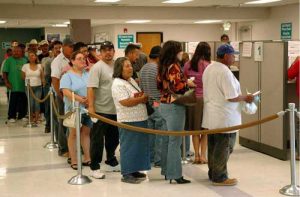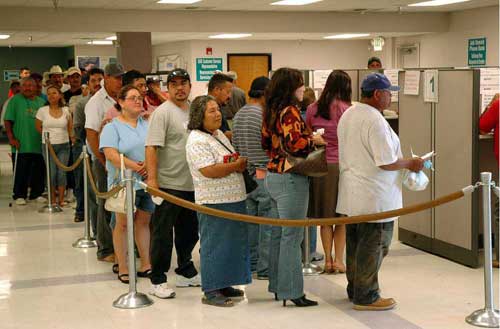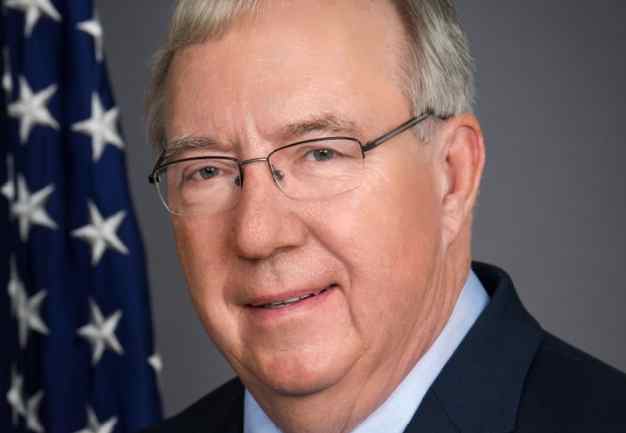
WASHINGTON – U.S. unemployment benefit claims jumped sharply last week, the Labor Department reported Thursday, as the surging number of coronavirus cases restricts many businesses throughout the world’s biggest economy.
Seasonally adjusted, a total of 853,000 laid-off workers filed for jobless compensation last week, up 137,000 from the revised figure of the week before. It was the first time since mid-October that the weekly figure had topped 800,000 after hovering in the 700,000-plus range for seven consecutive weeks.
With more than 200,000 new coronavirus cases being recorded every day recently, state governors and municipal officials have been imposing new restrictions on business activity, after lifting similar curbs months ago, when the virus seemed to ebb.
When the restrictions are imposed, businesses are often laying off workers. The layoffs are being imposed even as government health regulators are likely in the coming days to approve two coronavirus vaccines that could almost immediately be used to start to inoculate health care workers and nursing home patients in the first wave of shots to curb the pandemic in the U.S.
More than 289,000 people have been killed by the virus in the U.S. and 15 million infected, both world-leading figures, according to Johns Hopkins University.
The newest jobless claims figure – as has been the weekly total for nine months –remained above the highest pre-pandemic figure in records that date to the 1960s. Last week’s total extends the run of high weekly claim totals that started in mid-March when the coronavirus swept into the United States.
The 6.7% unemployment rate recorded in November is a marked improvement from the pandemic low point — a 14.7% jobless rate in April — but perhaps is somewhat artificially lower because the figure does not include people who have dropped out of the labor market and are not actively looking for work.
With new stay-at-home orders being imposed in some places with the worst outbreaks, the new restrictions could portend more U.S. workers being laid off in the coming weeks. Also, there are now about 10 million fewer jobs in the U.S. labor market than in February before the coronavirus hit the country.
[content id=”79272″]
Retail stores and restaurants are cutting hours if they are open, while entertainment and arts centers have canceled live shows. The travel and hospitality industries also have been hit hard. Colder winter weather in the U.S. also means that fewer outdoor gatherings are possible.
There has, however, been an uptick in shipping, technology and cybersecurity employment because of the number of Americans who have embraced stay-at-home shopping.
Lawmakers in Congress, stalemated for months on more coronavirus aid for unemployed workers, businesses and state and local governments, are talking again about approving more assistance beyond the $3 trillion they approved months ago, almost all of which already has been spent.
President-elect Joe Biden endorsed a $908-billion stimulus proposal by a bipartisan group of lawmakers that would include extra $300-a-week payments for jobless workers for four months, down from the $600-a-week stipends that expired at the end of July.
Another proposal would all but end extra jobless pay but instead send $600 checks to most Americans except top earners.
Biden said the proposed relief deal he supports “wouldn’t be the answer” to boosting the flagging U.S. economy, but would provide immediate relief for many and called for its approval this month. Biden has vowed to support bigger economic boosts once he is inaugurated January 20.
He told a group of workers a week ago, “To state the obvious, my ability to get you help immediately does not exist” until he assumes the presidency.
Whether an economic stimulus of any size is approved by Congress and signed by President Donald Trump in the last six weeks of his presidency is an open question. Congressional leaders are still negotiating but a final draft of relief legislation has yet to be written, although it could be within a week before lawmakers recess for the Christmas and New Year holidays.
The country’s Commerce Department says the economy surged at an annualized 33.1% rate from July to September, after an almost equal plunge from April to June, as the first wave of the coronavirus pandemic swept through the country.
Analysts believe that U.S. economic growth will end up being slower in the last three months of the year, especially if business restrictions are markedly increased, such as renewed limitations on indoor seating at restaurants.
Government officials have been reluctant to curtail business activity as much as they did in the March-to-June period, As the virus spreads, though, some state governors who refused to impose earlier restrictions now are ordering limitations.
Source: VOA






